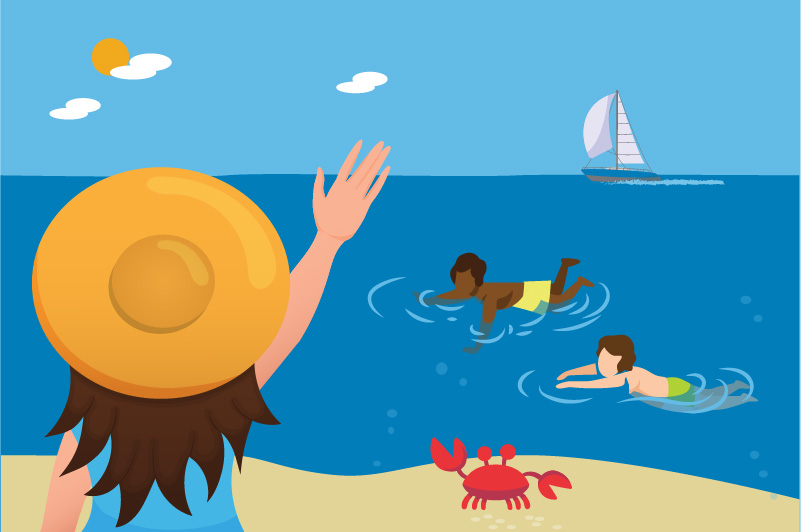Diving into summer: What to know about water safety

The sun is back, the temperatures are rising, and that means more of us will be heading towards the water to cool off. Whether your family is going to a pool, beach, lake, or pond, knowing how to keep your children safe when splashing in the water should be top of mind.
We recently spoke with Dr. Caitlin Farrell in Emergency Medicine and Dr. Valentine Esposito from Children’s Hospital Primary Care Center (CHPCC), who shared tips and advice to prevent drowning and other water-related injuries.
How to stay safe in and around the water
Dr. Farrell shares the first step that parents should take when learning about water safety is to fully understand just how serious it is. “Drowning is the leading cause of death for children ages 1 to 4 years old, so parents need to be extra vigilant when it comes to swimming and water time this summer.”
Drowning can happen within seconds, and being alert and actively watching kids in the water can help prevent potential accidents. “Have the adults in the area cycle through who is the ‘water watcher’. That means they’re not chatting with others or grabbing a snack; their only job is to watch the water and make sure no one is struggling,” says Farrell.
For an extra layer of safety, parents and caregivers should become CPR-certified. “Taking a CPR class can make all the difference. If a child does get into trouble, starting CPR as soon as possible increases their chance at surviving that drowning event,” explains Farrell.
How to talk to your child about water safety
If your child is going to be near water, make sure you know their swim skill level. “Having transparent conversations about swimming with your children, even when they are little, can save their lives,” explains Esposito. Getting your kids involved in swimming lessons can be a good way to promote strong swimming skills and teach them how to keep their heads above the water.
It’s important to talk to your teenagers about swimming strengths, too. Dr. Farrell notes that teen boys are at a higher risk of drowning in lakes, ponds, and open water when friends are around. This is largely because teen boys often show off in front of their peers or push themselves to keep up with stronger swimmers, when they might not be swimming at the same level. “At any age, safety is the top priority. Even at risk of being embarrassed in front of friends,” shares Farrell. “We also need to talk to teens about alcohol and water safety the same way we do about drinking and driving. It’s never safe to swim if teens have been drinking. Remind teens that everyone has different swimming skills and that it isn’t a race to be the best.” Dr. Esposito also reminds us that not all water is created equal; different bodies of water have different risks (oceans have riptides, lakes have sudden drop offs, etc.) so always swim with caution.
Staying safe at camp or at a friend’s pool
If you’re worried about your child or teen heading to camp this summer, Dr. Esposito offers support. “A swim test is typically given to campers to assess their skills and determine if a child is safe to participate in water activities.” Most camps have lifeguards and counselors who are CPR-certified, but parents should always confirm this. It’s also important for parents to make sure their children know and understand the camp’s rules and regulations around swimming.
When your child gets invited to a pool party or to a beach outing with friends, make sure you’re voicing your concerns about water safety with the adult who is going to be supervising. “Trust your instincts and never be afraid to talk to other parents about your child’s safety,” shares Esposito. “Voice what you and your child are comfortable with, ask who will be supervising the children, and if they are CPR trained.”
A few takeaway tips that Drs. Farrell and Esposito share for the summer include:
- Avoid swimsuits that match the color of the water and lean towards bright, colorful suits to stand out.
- To prevent unsupervised children falling or climbing into an uncovered pool, a four-sided fence surrounding the pool area is an essential safety measure. That way, children can’t access the pool without adult help.
- Don’t overcrowd your swimming area with pool toys and floats. Children can get stuck underneath or struggle moving around them.
Related Posts :
-

Why families need routines (even in the summer)
They say you don’t know what you have until it’s gone. Maybe no one has realized this more ...
-

Summertime Sadness: Helping children manage summer depression
Summer’s here, which means school is out and the sun is in. It’s everyone’s favorite season. Unless ...
-

Send your kids to camp with peace of mind: Safety guidelines to look for this summer
After this past year, it may be hard to remember what a “normal” summer feels like, but as communities reopen, ...
-

Keep summer activities as safe as possible
As we move into a summer with COVID-19, many people are slowly venturing beyond their homes as businesses, beaches, and ...





